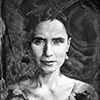The materiology of junk and scrap
Article Sidebar

Main Article Content
This essay explores the materiology of junk and scrap, focusing on their transformation through welding processes and conceptualizing trash as a time machine. Key elements include waste materials such as junk, wire, screws, locks, pipes, spare bike and machine parts and scrap, which are examined as valuable resources imbued with time through phenomena such as oxidation, rusting and corrosion. In my artistic and scientific work, through welding, pottery, poetry, digital and analogue filmmaking, theatrical productions, collages and writing, I analyse various creative practices as akin processes within materiology. Emphasizing hands-on engagement with materials, my research highlights the tactile aspects of moulding and transforming waste into new forms, in an alchemical process where mundane materials are transmuted into something of value. This interdisciplinary investigation sheds light on the profound connections between art, thought and the materiality of time and everyday detritus. This essay is informed by a year-long personal exploration during which I have engaged in welding and sculpture creation using scrap materials sourced from a neighbour’s garden – a space previously inhabited by the late Michael Lachmund, a painter, sculptor, educator and philanthropist who was also a collector of scrap.
Article Details

This work is licensed under a Creative Commons Attribution 4.0 International License.
(c) Aneta Panek, 2024
Copyright
For all articles published in Artnodes that are subject to a Creative Commons Attribution 4.0 International licence, copyright is retained by the author(s). The complete text the license can be consulted at http://creativecommons.org/licenses/by/4.0/. You may copy, distribute, transmit and adapt the work, provided you attribute it (authorship, journal name, publisher) in the manner specified by the author(s) or licensor(s).
Authors are responsible for obtaining the necessary licences for the images that are subject to copyright.
Assignment of intellectual property rights
The author non exclusively transfers the rights to use (reproduce, distribute, publicly broadcast or transform) and market the work, in full or part, to the journal’s editors in all present and future formats and modalities, in all languages, for the lifetime of the work and worldwide.
I hereby declare that I am the original author of the work. The editors shall thus not be held responsible for any obligation or legal action that may derive from the work submitted in terms of violation of third parties’ rights, whether intellectual property, trade secret or any other right.
Aneta Panek, Researcher, writer, filmmaker and performance artist
Aneta Panek is a Berlin-based researcher, filmmaker and performance artist working in the fields of theatre, opera and film. Recurrent themes in her work include alchemy, transmutation, subversion and rebellion as means of self-discovery. Based on other knowledge and performative research, she explores the necessity of visualization and associative speculation in formulating and deconstructing theories and questioning reality. She completed studies in art history and archaeology at the Sorbonne in Paris with MA and DEA diplomas, and earned her doctoral degree (Dr. Phil.) at the University of Arts Berlin, with a thesis on Alchemy of Punk. While her practice culminates in experimental film, she also stages performances and operas and writes analytical texts, poetry and compositions.
No references for the article
Similar Articles
- Nelson Brissac, Critical landscapes. Robert Smithson: art, science and industry , Artnodes: No. 9: (December 2009). NODE 9. Complexity (Editor: Pau Alsina, Josep Perelló)
- Ivan Flores Arancibia, Begonya Saez Tajafuerce, The trauma of the inert. Notes for a new parasitology , Artnodes: No. 27: (January 2021). Node 27. Arts in the Time of Pandemic (Guest Editors: Laura Benítez & Erich Berger)
- Rosa Barba, Inventory of cinematic spaces. A fictional library , Artnodes: No. 34: (July 2024). NODE 34. Materiology and variantology: invitation to dialogue (guest editors: Siegfried Zielinski & Daniel Irrgang)
- Miguel Ángel Roque, Exploring the intersection of art, technology, and social issues on Paglen’s work , Artnodes: No. 33: (January 2024). NODE 33. Media Artivism: On the Archaeology and History of Digital Culture for Social Change (Guest Editors: Carolina Fernández-Castrillo & Diego Mantoan)
- Jussi Parikka, New Materialism of Dust , Artnodes: No. 12: (November 2012). NODE 12. Materiality (Editor: Pau Alsina)
- Edward Shanken, New Media, Art-Science, and Contemporary Art: Towards a Hybrid Discourse? , Artnodes: No. 11: (November 2011). NODE 11. Hybrid Discourses (coord.: Pau Alsina)
- Pau Alsina, Progress, tradition and history in times of crisis , Artnodes: No. 9: (December 2009). NODE 9. Complexity (Editor: Pau Alsina, Josep Perelló)
- Slavko Kacunko, Big Bacteria for Micro-Humans. Bacteria as an archeological - ecological nexus for an integrative form of health and heritage research , Artnodes: No. 16: (November 2015). NODE 16. Art Matters II (Editor: Ana Rodríguez Granell)
- Rob Wittig, What world are you from? Learning from the transmedia roots of netprov , Artnodes: No. 18: (November 2016). NODE 18. Transmedia narratives (Editor: Pau Alsina)
- Ana Rodriguez Granell, Back to the Future. Or the perpetual future nostalgia , Artnodes: No. 19: (June 2017). NODE 19. Art and speculative futures (coord.: Ana Rodriguez Granell)
<< < 1 2 3 4 5 6 7 8 9 10 > >>
You may also start an advanced similarity search for this article.